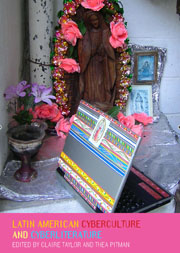Book contents
- Frontmatter
- Contents
- List of Illustrations
- Acknowledgements
- Foreword: Latin American Cyberliterature: From the Lettered City to the Creativity of its Citizens
- Notes on Contributors
- Introduction
- I Cyberculture and Cybercommunities
- II Cyberliterature: Avatars and Aficionados
- 9 Posthumanism in the Work of Jorge Luis Borges
- 10 Julio Cortázar's Rayuela and the Challenges of Cyberliterature
- 11 Contemporary Brazilian Fiction: Between Screens and Printed Pages
- 12 Creative Processes in Hypermedia Literature: Single Purpose, Multiple Authors
- 13 Hypertext in Context: Space and Time in the Hypertext and Hypermedia Fictions of Blas Valdez and Doménico Chiappe
- 14 Virtual Bodies in Cyberspace: Guzik Glantz's Weblog
- A Cyberliterary Afterword: Of Blogs and Other Matters
- Conclusion: Latin American Identity and Cyberspace
- Suggested Further Reading
- Index
10 - Julio Cortázar's Rayuela and the Challenges of Cyberliterature
from II - Cyberliterature: Avatars and Aficionados
- Frontmatter
- Contents
- List of Illustrations
- Acknowledgements
- Foreword: Latin American Cyberliterature: From the Lettered City to the Creativity of its Citizens
- Notes on Contributors
- Introduction
- I Cyberculture and Cybercommunities
- II Cyberliterature: Avatars and Aficionados
- 9 Posthumanism in the Work of Jorge Luis Borges
- 10 Julio Cortázar's Rayuela and the Challenges of Cyberliterature
- 11 Contemporary Brazilian Fiction: Between Screens and Printed Pages
- 12 Creative Processes in Hypermedia Literature: Single Purpose, Multiple Authors
- 13 Hypertext in Context: Space and Time in the Hypertext and Hypermedia Fictions of Blas Valdez and Doménico Chiappe
- 14 Virtual Bodies in Cyberspace: Guzik Glantz's Weblog
- A Cyberliterary Afterword: Of Blogs and Other Matters
- Conclusion: Latin American Identity and Cyberspace
- Suggested Further Reading
- Index
Summary
Rayuela, the Book
In 1963 the novel Rayuela [Hopscotch], by Julio Cortázar, was published in Argentina, two years before Ted Nelson coined the word ‘hypertext’ (Labbé 1996). The rapidly gained cult status and reputation of Rayuela owed much to its physical appearance and entity as a big black brick of a book, which when opened immediately cast off its guise as a novel and announced itself as a labyrinth of texts whose reading order could, if the reader chose, be ordained by a numerical chart. This was presented with the following gloss: ‘this book is many books, but above all it is two books’ (Cortázar 1970: ‘Table of Instructions’). One could be read from chapter 1 to chapter 55, the other following the chart. Reading this was like being given the keys to Aladdin's cave, and given choices that could lead to endless treasures, or to abominable trapdoors. The reader could choose to go straight to chapter 73, and read that ‘yes, but …’ which is both affirmation and caveat, certainty and doubt, existential dilemma: ‘yes, but who will cure us of the muffled fire, the colourless fire that runs along the Rue de la Huchette at nightfall’ (Cortázar 1970: 438). When the reader jumped to chapter 1, as indicated at the end of this text – chapter 73 – buried in the depths of the volume, the quest was on: ‘Would I find La Maga?’ (Cortázar 1970: 15).
- Type
- Chapter
- Information
- Latin American Cyberculture and Cyberliterature , pp. 194 - 206Publisher: Liverpool University PressPrint publication year: 2007



